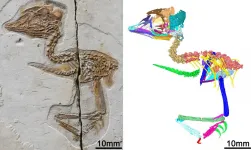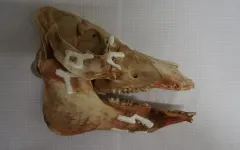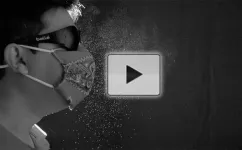INFORMATION:
Tiny ancient bird from China shares skull features with Tyrannosaurus rex
2021-06-23
(Press-News.org) Researchers from the Institute of Vertebrate Paleontology and Paleoanthropology (IVPP) of the Chinese Academy of Sciences have discovered a 120-million-year-old partial fossil skeleton of a tiny extinct bird that fits in the palm of the hand and preserves a unique skull with a mix of dinosaurian and bird features.
The two-centimeter-long (0.75 inch) skull of the fossil shares many structural and functional features with the gigantic Tyrannosaurus rex, indicating that early birds kept many features of their dinosaurian ancestors and their skulls functioned much like those of dinosaurs rather than living birds.
Their findings were published in Nature Communications on June 23.
The bird was deposited 120 million years ago in a shallow lake in what is today Liaoning Province in northeastern China.
Through detailed reconstruction of the bird family tree, the researchers demonstrated that the new fossil bird species belongs to an extinct group of birds called enantiornithines, or "opposite birds." They are the most diverse group of birds from the time of the dinosaurs in the Cretaceous and have been found all over the world.
In living birds, the quadrate is one of the most movable bones in the skull and allows for the unique feature of living birds known as "kinetic skull," which allows the upper jaw to move independently of the brain and the lower jaw.
In contrast with living birds, however, the skull of this new "opposite bird", as well as those of dinosaurs like Tyrannosaurus rex and the close dinosaurian relatives of birds (e.g., troodontids and dromaeosaurs), is not kinetic. Instead, its bones are "locked up" and unable to move.
The temporal regions (sides) of the skull of this bird fossil are very different from living birds. This new species has two bony arches for jaw muscle attachment like those found in reptiles such as lizards, alligators, and dinosaurs, making the rear of the skull rigid and resistant to movement among the bones.
"When reconstructing all parts of the skull three-dimensionally from the high resolution CT scans of the fossil, I had a problem figuring out one bone in particular," said Dr. WANG Min, the lead and corresponding author of the study. He said his colleague Dr. Thomas Stidham proposed that the bone was the pterygoid and looked "exactly like that of the dromaeosaur Linheraptor." The fossil has the first well-preserved pterygoid bone found in an early bird.
The researchers compared CT scans of the bird skull to scans of the skull of the well-known dromaeosaur Linheraptor from Inner Mongolia, China. The results showed that many other features of the rear portion of the skull, including the shape of the basisphenoid bone and its connections with other skull bones, also resemble dromaeosaurs rather than living birds.
"The fossil bird and dinosaurs also lack the discrete contact between the pterygoid and quadrate near the palate that is used in skull kinesis in living birds. In combination with the 'locked up' temporal bones, the difference in the palate structure also points to the absence of kinesis among early birds," said Dr. Stidham, co-author of the study.
Furthermore, the team's discovery and meticulous anatomical research help to reinforce the already well-supported contention, based on many different lines of evidence, that birds are not only living dinosaurs, but evolved from the branch of dinosaurs that includes troodontids and dromaeosaurs like the "four-winged" Microraptor and swift Velociraptor.
"Having a 'dinosaur' skull on a bird body certainly did not stop the enantiornithines, or other early birds, from being highly successful in places all around the world for tens of millions of years during the Cretaceous," said Dr. WANG.
ELSE PRESS RELEASES FROM THIS DATE:
University of Minnesota Medical School report details the effects of COVID-19 on adolescent sexual health
2021-06-23
MINNEAPOLIS/ST. PAUL (06/23/2021) -- A new report from the University of Minnesota Medical School's Healthy Youth Development - Prevention Research Center (HYD-PRC) highlights that Minnesota youth continue to contract sexually transmitted infections (STIs) at alarmingly high rates, despite the COVID-19 pandemic.
The 2021 Minnesota Adolescent Sexual Health Report says that chlamydia and gonorrhea rates among Minnesota adolescents in 2020 are likely underreported, as both STI testing and case detection were scaled back during the early stages of the pandemic. However, teen pregnancy rates remain virtually unchanged from 2018, and birth rates are at historic lows for ...
Odd smell: flies sniff ammonia in a way new to science
2021-06-23
The stink of ammonia in urine, sweat, and rotting meat repels humans, but many insects find ammonia alluring. Now, UConn researchers have figured out how the annoying insects smell it, a discovery that could lead to better ways to make them buzz off.
The sense of smell is enormously important. Mammals devote a third of their genetic code to odor receptors found in the nose, and have more than 1,000 different kinds that allow us to smell an estimated trillion different odors.
Flies don't have noses. Instead, they smell with their antenna. Each antenna is covered with tiny hairs called sensilla. Each sensilla contains a few neurons--fly brain cells. Each neuron expresses one type of odor receptor, and they all fall into two main ...
Fracture setting method could replace metal plates, with fewer complications
2021-06-23
A new biocompatible polymer-based composite material could soon replace metal plates in treating difficult and unstable fractures. Developed at KTH Royal Institute of Technology in Stockholm, the newly-developed material is as strong as dental composites yet non-toxic.
The material and a surgical method, which were published in Advanced Functional Materials, will be used in clinical studies in 2023 and 2024, with a focus on hand fractures.
Michael Malkoch, professor of fibre and polymer technology at KTH, says that the material and method, AdhFix, will enable customized plating for fixation of fractures with a more comfortable, less complicated recovery. Collarbone and rib fractures in particular are ideally suited for the proposed treatment, ...
Sneeze cam reveals best fabric combos for cloth masks (video)
2021-06-23
During the COVID-19 pandemic, cloth face masks became a way to help protect yourself and others from the virus. And for some people, they became a fashion statement, with many fabric choices available. But just how effective are they, especially in containing a sneeze? Now, researchers reporting in ACS Biomaterials Science & Engineering used high-speed videos of a person sneezing to identify the optimal cloth mask design. Watch a video of the sneeze cam here.
Early in the pandemic, worldwide shortages of surgical masks and N95 respirators led many people to make or purchase cloth face masks. Now, with safe and effective COVID-19 vaccines available, mask restrictions are ...
'Lady luck' - Does anthropomorphized luck drive risky financial behavior?
2021-06-23
A new study published in the Journal of the Association for Consumer Research posits that increased accessibility to anthropomorphized luck (i.e., "lady luck") can lead consumers to be more likely to pursue higher-risk financial behavior. In "Lady Luck: Anthropomorphized Luck Creates Perceptions of Risk-Sharing and Drives Pursuit of Risky Alternatives," authors Katina Kulow, Thomas Kramer, and Kara Bentley propose that preferences for higher-risk options (like lottery tickets with worse odds or investment opportunities with a low chance of return) are driven by shared risk perceptions that might engender feelings of security provided by the idea of "lady luck." This behavior, the authors note, "bodes ill for consumer welfare, given that many financial maladaptive activities ...
People willing to pay more for coffee that's ethical and eco-friendly, meta-analysis finds
2021-06-23
Beyond how much cream and sugar to add to their morning brew, coffee lovers also face more serious decisions: one of those is whether or not to buy ecolabelled coffee, which advertises itself as more ethical and environmentally friendly. But whether customers are willing to pay the extra price for these perks remains an unanswered question. In a study publishing in the journal Heliyon on June 23, researchers combined data from 22 studies to conclude that in general, people are willing to pay $1.36 more for a pound of coffee that's produced in an eco-friendly way and are especially partial to coffee that's labelled "Organic."
"We hear in the media or sometimes read in the newspaper that there ...
Low-cost imaging technique shows how smartphone batteries could charge in minutes
2021-06-23
Researchers have developed a simple lab-based technique that allows them to look inside lithium-ion batteries and follow lithium ions moving in real time as the batteries charge and discharge, something which has not been possible until now.
Using the low-cost technique, the researchers identified the speed-limiting processes which, if addressed, could enable the batteries in most smartphones and laptops to charge in as little as five minutes.
The researchers, from the University of Cambridge, say their technique will not only help improve existing battery materials, ...
Pleistocene sediment DNA from Denisova Cave
2021-06-23
Denisova Cave is located in the Altai Mountains in southern Siberia and is famous for the discovery of Denisovans, an extinct form of archaic humans that is thought to have occupied large parts of central and eastern Asia. Neandertal remains have also been found at the site, as well as a bone from a child who had a Neandertal mother and Denisovan father, showing that both groups met in the region. However, only eight bone fragments and teeth of Neandertals and Denisovans have been recovered so far from the deposits in Denisova Cave, which cover ...
Quantum birds
2021-06-23
Humans perceive the world around them with five senses - vision, hearing, taste, smell and touch. Many other animals are also able to sense the Earth's magnetic field. For some time, a collaboration of biologists, chemists and physicists centred at the Universities of Oldenburg (Germany) and Oxford (UK) have been gathering evidence suggesting that the magnetic sense of migratory birds such as European robins is based on a specific light-sensitive protein in the eye. In the current edition of the journal Nature, this team demonstrate that the protein cryptochrome 4, found in birds' retinas, is sensitive to magnetic fields and could well be the long-sought magnetic sensor.
First ...
Antibody therapy rescues mice from lethal nerve-muscle disease
2021-06-23
Researchers rescued mice from early death caused by a muscle-weakening disease, not by correcting the flawed gene that causes it, but instead by targeting another protein in the same signaling pathway.
Led by NYU Grossman School of Medicine researchers, a new study found that an antibody treatment not only rescued young mice from a form of congenital myasthenia (CM) but also reversed disease relapse in adult mice.
Published online in the journal Nature on June 23, the study revealed new details of the cause of CM, with the better understanding guiding ...




